Chapter 2 The First Civilizations
Section
3
Like Mesopotamia and Egypt, the first
civilizations in India and China developed in the basins of great rivers.
The
first civilization of which we have so far found evidence on the Indian subcontinent
developed in the Indus River valley of present-day Pakistan. In China the first
signs of civilization are found in the Huang He and Yangtze River Valleys. While
the first Indian civilization developed into a complex urban culture early on,
the first Chinese cultures did not develop cities until much later. Uncovering
information about life in early India and China has been more difficult than
learning about ancient Mesopotamia or Egypt.
INTERNET RESOURCE: The Indus Valley Civilization
The
Indus River Valley
The Indus Valley is a broad plain hemmed in by desert to the east and mountains to the west. Geographically, it is much like the valleys of the Nile, the Tigris and the Euphrates. The flooding of the river provides both the water essential for agriculture and enriching silt that replenishes the soil. With its source in the Himalayas, the Indus River floods when the mountain snows melt in the spring. It also floods when the monsoons, seasonal rain-bearing winds, bring heavy rains to the western Himalayas. Otherwise, the surrounding land is relatively dry and may be easily cleared for settlement and agriculture, even without the use of iron tools.
Given such ideal conditions, it is perhaps little wonder that by about 3000 B.C. people lived along the Indus River in small, widely scattered villages of mud-brick houses. Although these people mainly used stone tools, they were also beginning to use metals such as copper. As in Sumer and Egypt, the production of surplus food by means of irrigation agriculture seems to have led to the development of cities in the Indus River Valley. By about 2500 B.C. a full-fledged civilization had emerged.
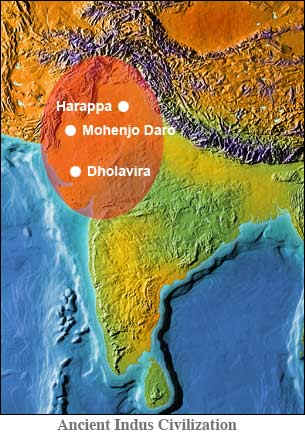
http://www.harappa.com/har/gif/ancient-indus-map.jpg
Harappan Civilization. The two most important cities in the Indus Valley civilization were Mohenjo-Daro on the lower Indus, and Harappa, 400 miles to the northeast. Harappa has provided archaeologists and historians with so much evidence of early Indus Valley life that they have named the civilization in this area Harappan civilization. From about 2300 to 1750 B.C. Harappan civilization expanded over an area larger than all of Sumer. Despite its enormous expanse, the civilization was remarkably uniform. Weights and linear measures were the same throughout the region, as were the types of copper and bronze tools people used. Many scholars believe that such uniformity of cultural elements also points to some sort of political unity in the region.
Whether
the entire region was unified politically or not, the cities of Harappa and
Mohenjo-Daro at least were extraordinarily well planned according to highly
sophisticated designs. Each city had a population of about 35,000 - all of whom
lived in an area roughly a mile square. Each city had a strong central fortress,
or citadel, to the west, while to the east lay the houses and public buildings.
Each city was also laid out on a grid pattern, so that streets intersected at
right angles.
The
buildings of Harappa and Mohenjo-Daro were designed for practical use. Many were
constructed with durable burnt bricks that had been baked in kilns, or ovens –
a process that made them far stronger than the sun-dried bricks commonly used in
Mesopotamia. Houses faced inward on open interior courtyards apparently to
ensure privacy, but also perhaps for security. The walls along the main streets
were solid brick, broken only by openings for drainage chutes. Almost every
house had its own bathroom, with brick floors and covered drains that carried
wastewater to the main street drains of the city's water removal system. Some
homes had their own wells, while others used public water sources. The
engineering skill demonstrated by the Harappans in these water and drainage
systems would not be matched again until the time of the Roman Empire, over two
thousand years later.
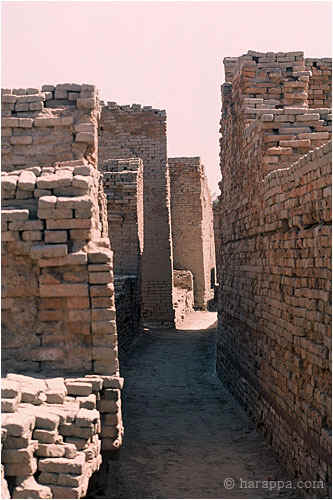
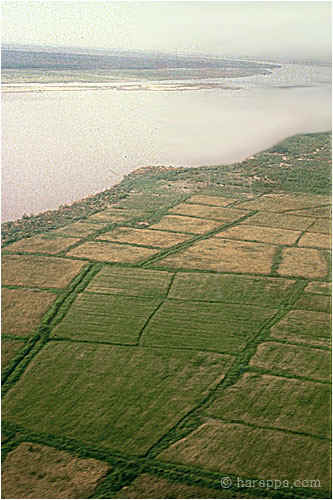
A narrow lane at Mohenjo-daro (left), http://www.mohenjodaro.net/images/mohenjodarostreet63.jpg; the Indus River at Mohenjo-daro (right), http://www.mohenjodaro.net/images/indusriver2.jpg
Although
Harappan civilization was apparently urbanized and sophisticated, farming
remained essential to the survival of city residents. The most important crop
was wheat, but farmers also grew barley, peas, dates, and mustard seeds. The
Harappans also kept a wide variety of animals, including cattle, pigs, goats,
and sheep. City-dwellers worked primarily in industry or trade. Indus Valley
artisans produced fine articles, including excellent cotton cloth, painted
pottery, artistic bronze sculpture, copper and bronze weapons and tools, and
gold and silver jewelry. As early as 2500 B.C. they appear to have been trading
these goods with Mesopotamian merchants.
Although for many years scholars assumed that the people of the Harappan civilization had developed a writing system comparable to those of Egypt and Mesopotamia, recent research has challenged this view. Archaeologists have found what appear to be pictographs, usually in the form of cylinder seals, dating from about 2300 B.C. Additional symbols have been found on clay pots and pottery fragments. Unfortunately, no one so far has been able to decipher any of the symbols or to demonstrate definitively their connection with any particular language. Nor do all scholars agree that the symbols actually represent the written form of an spoken language. They may simply be symbols universally recognized throughout the Harappan culture zone - rather like the symbols found on modern traffic signs or in airports, hospitals and other public buildings. Perhaps they represented gods and goddesses, or natural objects such as the sun, moon or stars, or animal spirits, which people used as charms or magical talismans to ward off evil or to invoke blessings and luck. It has also been suggested that the seals were used in trade either as elementary forms of identification, much like the coats of arms of medieval Europeans, or as rudimentary means of identifying and counting products. So far no inscriptions have been found that are long enough to suggest anything like complex documents or literature. On the other hand, as traditional scholarly views have held, they may be a combination of pictograms and ideograms, pictures that convey whole words or ideas, and representations of syllabic sounds, or a combination of all three, like the hieroglyphs of ancient Egypt. Without further discoveries and research we can only speculate.
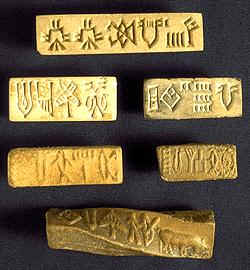
Examples of the Indus Valley script, http://indoeuro.bizland.com/project/script/indus.jpg
If
Harappan society was preliterate it may help to explain why no Harappan temples,
shrines, or religious writings have been found - although scholars believe that the
Indus Valley inhabitants worshipped a great god and used certain animal images
– the bull, buffalo, and tiger – in religious ceremonies. Some evidence also
points to the worship of a mother goddess who apparently symbolized fertility.
There is even a hint in some depictions that the Harappans may have
practiced human sacrifice. It does seem clear that they had some sort of
belief in an afterlife, however, since they generally buried their dead
formally, with personal possessions such as pottery or
jewels. Some were buried in large brick chambers, but most were buried
outstretched
on their backs with their heads pointing north. At the city of Lothal, about 400
miles southeast of MohenjoDaro, archaeologists have found several double
graves, each containing a male and female skeleton.
Harappan
decline. Despite
this rich and thriving culture, the most extensive in the ancient world, the
unity of Harappan civilization shattered sometime around 1500 B.C., for
reasons that scholars continue to debate. For many years, most researchers
believed that invaders had destroyed the civilization. More recently, however,
others have suggested dramatic climatic or environmental shifts may have
precipitated Harappan decline. Some evidence, for example, points to rapidly
occurring changes in the course of the Indus River that might seriously have
disrupted agriculture. Other scholars believe that major earthquakes and
flooding struck the region about 1700 B.C. The discovery of several unburied
skeletons, together with homes and personal belongings hastily abandoned,
seems to indicate some disastrous event at Mohenjo-Daro – though whether it
was environmental or human in origin - or a combination of both - no one can tell. Perhaps the earlier
notions of invasion are not entirely without merit. Without further evidence,
however, we can only continue to speculate and to make educated guesses.
Origins of
Civilization in China
INTERNET RESOURCE: Neolithic China
During
the Neolithic era, the first settlements in China were along the Huang He, or
Yellow River, which flows through the great plain of northern China. In the
valley of the Huang He, nomadic peoples settled in areas between wooded hills
and swampy lowlands, where enough plants and animals existed to keep them alive
even when their farming might not be successful.
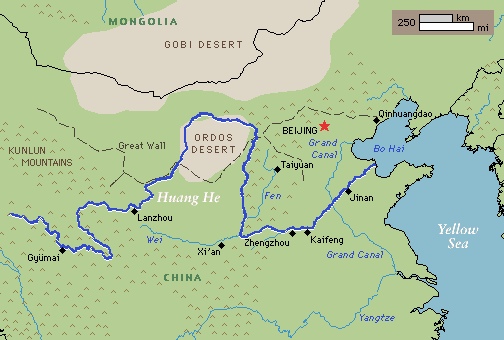
The
climate of the Huang He valley. Like other ancient civilizations, Chinese civilization
originated in regions with fertile soil and plentiful water supplies. Over many
centuries the prevailing winds of North China had deposited a fine yellow dust
along the North China Plain. This dust formed into a very rich soil called loess
(LEs), which in some places formed a layer 350 feet thick. This fine yellow dust
was also carried along in great quantities by the Huang He, which got its name
from the yellow silt created by the dust. Much of the silt was deposited on the
riverbed, which made the Huang He too shallow for navigation, though still
useful for irrigation, and created new lowland.
Every few years, particularly after heavy rains, the Huang He would overflow its banks in destructive floods. Raging floodwaters often destroyed everything in their path, turning once usable farmland into waterlogged swamps. Such destructive floods led the ancient Chinese to nickname the Huang He "China's Sorrow." The general climate in the valley of the Huang He was also severe. Winters were long and cold, summers short and hot. Dust storms swept across the valley in the spring. Rainfall too was unpredictable and heavy rains alternated with periods of drought and famine.
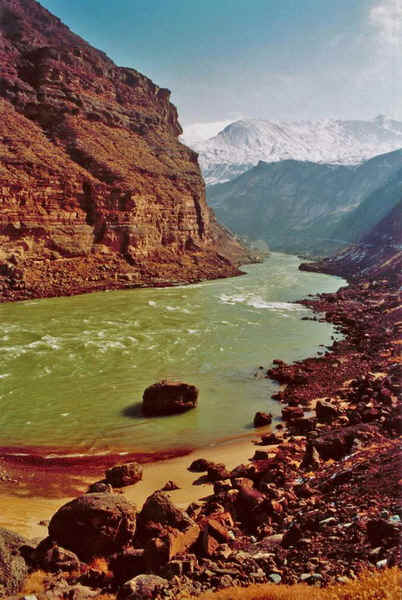
The Huang He near the beginning of the river valley in Qinghai province of northwestern China, http://en.wikipedia.org/wiki/Yellow_River
Yangshao
Culture.
The earliest Neolithic culture so far discovered in China is called the
Yangshao, after the village in Henan province, in northern China, where its artifacts were first found.
Between about 5000 and 3000 B.C., Yangshao culture spread over a fairly wide
area around the middle of the Huang He and one of its major tributaries, the Wei
River. Archeologists recognize Yangshao
culture largely by its characteristic painted pottery. Apparently unfamiliar
with the potter's wheel, Yangshao artisans formed their pottery by hand, then
decorated it with pictures of fish, animals, plants and geometric forms.
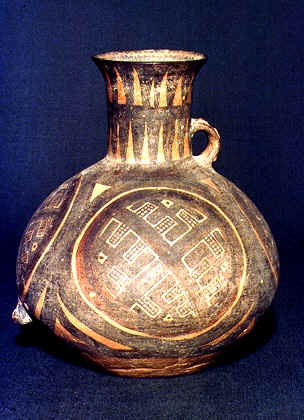
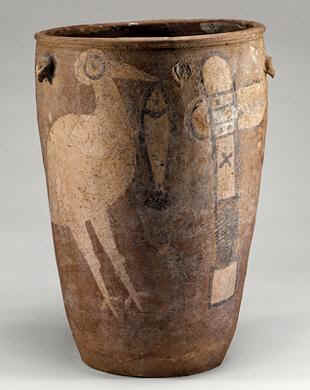

Examples of Yangshao painted pottery, http://www2.hawaii.edu/~kjolly/151/images/Yangshao.jpg; http://www.nga.gov/education/chinatp_sl02.htm
Although
people in the Yangshao culture were farmers, they also hunted and fished. They
relied solely on human labor in their farming techniques, tilling the soil by
hand with hoes since they did not yet have the plow. Millet seems to have been
the most important grain crop, although some villages also grew wheat and even
rice. They also domesticated a number of animals, particularly the dog and the
pig, and later apparently ; they also raised pigs and sheep. In addition,
farmers grew hemp, which they made into cloth, and there is even some evidence
that Yangshao farmers may have raised silkworms.
The
people of the Yangshao culture built their houses in clusters. Some
archaeologists have argued that this suggests a clan structure in which people
lived in groups of related families. If this interpretation proves correct, it
would be the earliest example of the strong, clan-based type of society that is
a feature of later Chinese civilization. At any rate, as Yangshou culture spread
it provided a foundation on which a more sophisticated culture would soon build.
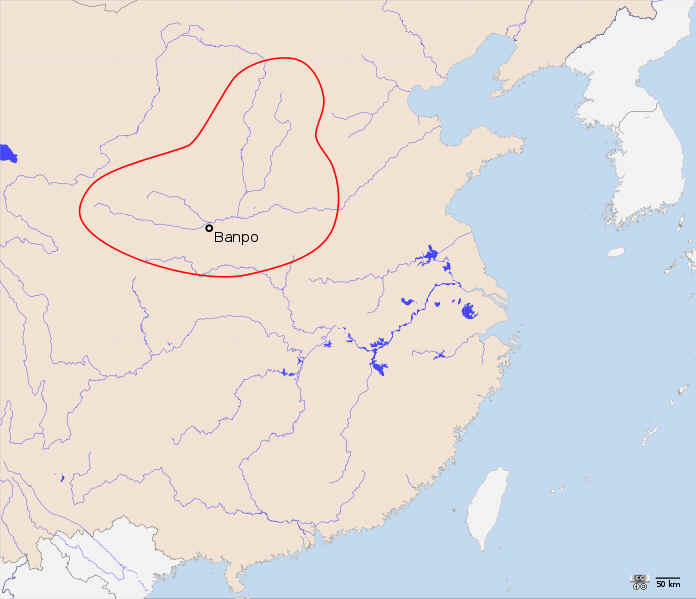
Extent of Yangshao culture, http://en.wikipedia.org/wiki/Yangshao_culture.
Longshan
Culture.
Known as Longshan, from the first site discovered by archaeologists in the
1930s, this second Neolithic culture became more complex and widespread than
Yangshao. From about 3000 or 2600 (scholars debate the dating) to 2000 B.C.
Longshan Culture flourished on the North China plain and along the eastern
seaboard of Central China. It also spread over all those areas that had been
part of the Yangshao cultural zone. Since its discovery, modern scholars have
primarily recognized Longshan Culture by its distinctive, highly polished and
delicate black pottery. Unlike Yangshao potters, the artisans of Longshan
were the first in east Asia to use a high-speed wheel on which to throw their
pots. They also fired them in kilns at very high heat.
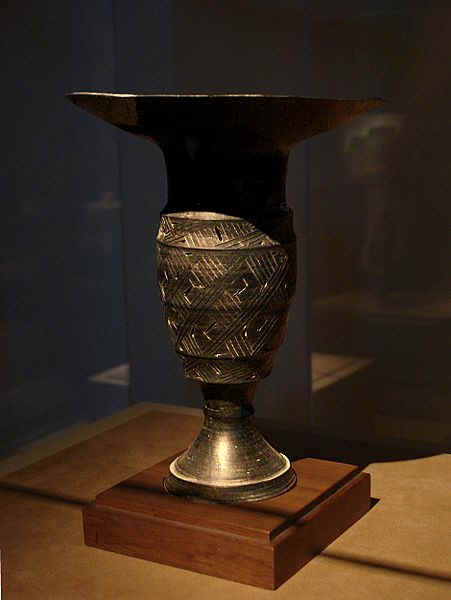
Example of Longshan Black Eggshell Pottery, http://media-2.web.britannica.com/eb-media/24/42524-004-7415436A.jpg
The
Longshan were also farmers, though unlike the Yangshao they appear to have
depended more heavily on rice cultivation than millet or wheat. Wet-field rice
farming is highly labor intensive and requires enormous coordination to create
the dikes and channels with which to get river water to flood the paddies. On
the other hand, it is also about eight times more productive than millet or
wheat farming. A culture relying on rice can produce greater surpluses and
sustain a much larger population than one relying on other grains.
Even
more important for the development of civilization in China, however, Longshan
Culture was apparently the first to begin to build relatively large fortified
towns. The Longshan people developed a new technology for construction that
involved rammed-earth walls and platforms. As their culture developed, they
increasingly used these techniques to build large walls around their
settlements. From all the archaeological remains, it seems that Longshan
builders also preferred higher ground for their cities, on small hills or
knolls, where they could look down over the plains below. Such strategic
thinking suggests that the Longshan were concerned with defense against enemies.
In
addition to building such major fortified cities, the Longshan also began to use
bronze artifacts. Jade too became enormously important, at least partly as a
symbol of status. While we have no real knowledge of their religious customs,
they practiced human as well as animal sacrifice regularly, and when rulers
died, wives, concubines and other servants were often buried alive to keep them
company in the grave.
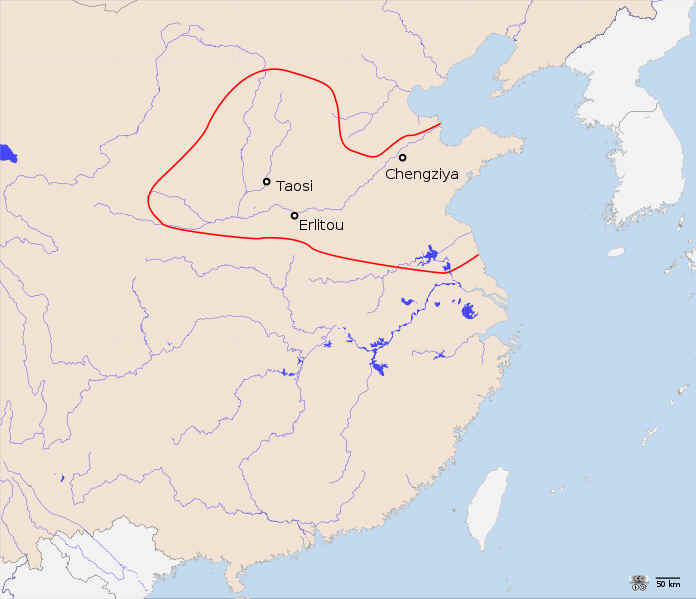
Extent of Longshan Culture, http://en.wikipedia.org/wiki/Longshan_culture.
Many
Chinese scholars have become convinced that Longshan Culture is the
“mythical” Xia dynasty, which according to ancient Chinese tradition was the
first dynastic state in China. The discovery and excavation of a major city from
the late Longshan period in 2002-2004 at Wangchenggang
near Dengfeng in Henan Province has only reinforced this conviction.
There, archaeologists have discovered sacrificial pits
with human bones, human skulls used in rituals, long hollow pieces of jade
with rectangular sides, and white pottery, which demonstrated the noble status of
the owner. At a nearby site, in 1977, archaeologists had already discovered a
smaller city containing fragments of bronze wares and building foundation pits
containing the skeletons of human sacrifices. They even discovered inscribed
characters that may be a form of writing, though it has so far remained
undeciphered. In short, although we have no written records to guide us,
it seems reasonable to suggest that Longshan Culture was comparable to the
city-states of Sumer. At the very least, it is increasingly clear that Longshan
Culture was indeed the base on which the first historical dynasty, the Shang,
would eventually build.